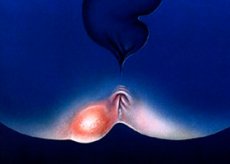Medical expert of the article
New publications
Paraproctitis
Last reviewed: 05.07.2025

All iLive content is medically reviewed or fact checked to ensure as much factual accuracy as possible.
We have strict sourcing guidelines and only link to reputable media sites, academic research institutions and, whenever possible, medically peer reviewed studies. Note that the numbers in parentheses ([1], [2], etc.) are clickable links to these studies.
If you feel that any of our content is inaccurate, out-of-date, or otherwise questionable, please select it and press Ctrl + Enter.

Paraproctitis is an inflammation of the tissue (pararectal) surrounding the rectum. Of the total number of proctological diseases, paraproctitis accounts for 15.1%. Paraproctitis usually develops in the anal crypts. Symptoms of paraproctitis are pain and swelling.
An anorectal abscess is a limited accumulation of pus in the pararectal area.
Causes paraproctitis
It is believed that men suffer from paraproctitis more often than women. If we take into account the reports of various authors, this ratio varies from 1.5:1 to 4.7:1. Despite the fact that paraproctitis is considered mainly a disease of adults, it also occurs in children. One series of observations described 200 cases of paraproctitis in children aged from the neonatal period to 14 years.
There are 3 fascial-cellular spaces: subcutaneous, ischiorectal and pelvic-rectal. Accordingly, paraproctitis is divided into subcutaneous, submucous, ischiorectal and pelvic-rectal. Paraproctitis is caused by various microorganisms that penetrate into the cellular spaces from the rectum through the anal glands, damaged mucous membrane, as well as hematogenous or lymphogenous from neighboring organs affected by the inflammatory process.
Of particular importance in the pathogenesis of paraproctitis is direct damage to the rectal mucosa in the area of the posterior wall of the anal canal, where wide and deep crypts are located, which are the entry points for infection. From 6 to 8 anal gland ducts open into each crypt. Through them, the infection spreads to the pararectal cellular spaces. In most patients (98%), paraproctitis is nonspecific and is caused by staphylococci in combination with E. coli. Specific infection (tuberculosis, actinomycosis, syphilis) is observed in 1-2% of patients with paraproctitis.
Paraproctitis may be localized in various areas surrounding the rectum and may be superficial (subcutaneous) or deep. Perianal abscesses are located superficially under the skin. An ischiorectal abscess is deeper, extending from the sphincter into the ischiorectal space below the levator ani muscle; the abscess may extend to the opposite side, forming a "horseshoe" abscess. An abscess above the levator ani muscle (i.e., supramuscular abscess, pelviorectal abscess) is located deep enough and may reach the peritoneum or abdominal organs; this abscess is often a consequence of diverticulitis or pelvic inflammatory disease. Sometimes, an anorectal abscess is a manifestation of Crohn's disease (especially of the colon). Usually a mixed infection is present, including Escherichia coli, Proteus vulgaris, Bacteroides, streptococci with a predominance of staphylococci.
Symptoms paraproctitis
Superficial abscesses may be accompanied by severe pain; swelling in the perianal area, hyperemia, and pain are characteristic. Deeper abscesses may be less painful, but may cause signs of intoxication (e.g., fever, chills, malaise). Local symptoms of paraproctitis are sometimes absent on examination, but digital rectal examination may reveal pain in the intestinal wall and a fluctuating protrusion of the wall. High pelviorectal abscesses may cause pain in the lower abdomen and fever without signs from the rectum. Sometimes fever is the only symptom of the disease.
How to examine?
Who to contact?
Treatment paraproctitis
Treatment of paraproctitis involves surgical drainage.
Spontaneous rupture of the abscess should not be allowed; prompt incision and adequate drainage of the abscess are necessary. Superficial abscesses may be drained in the office; deeper abscesses require drainage in the operating room. Patients with fever or diabetes mellitus require antibiotics (eg, ciprofloxacin 500 mg IV every 12 hours and metronidazole 500 mg IV every 8 hours, ampicillin/sulbactam 1.5 g IV every 8 hours); patients with subcutaneous abscesses do not require antibiotics. Anorectal fistulas may develop after drainage.


 [
[